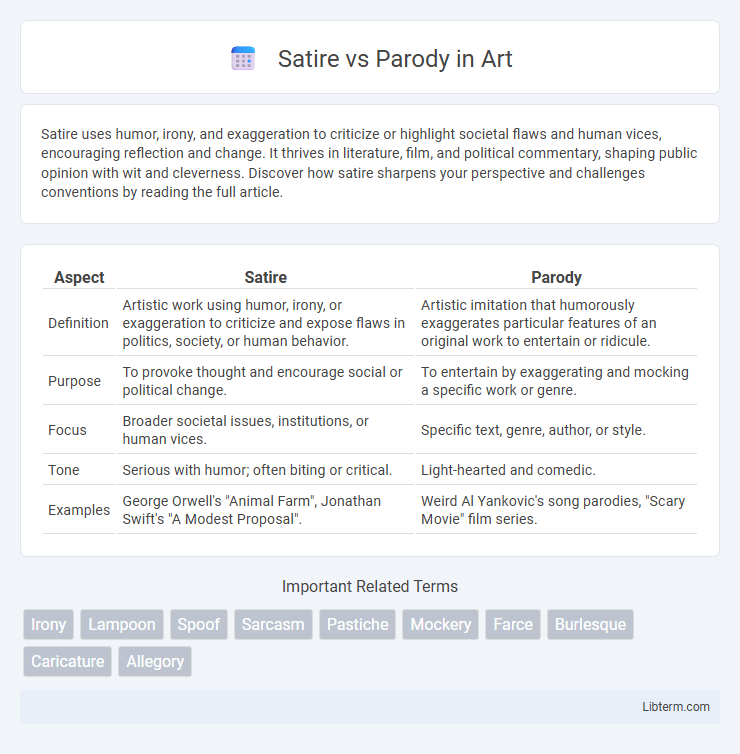Satire uses humor, irony, and exaggeration to criticize or highlight societal flaws and human vices, encouraging reflection and change. It thrives in literature, film, and political commentary, shaping public opinion with wit and cleverness. Discover how satire sharpens your perspective and challenges conventions by reading the full article.
Table of Comparison
| Aspect | Satire | Parody |
|---|---|---|
| Definition | Artistic work using humor, irony, or exaggeration to criticize and expose flaws in politics, society, or human behavior. | Artistic imitation that humorously exaggerates particular features of an original work to entertain or ridicule. |
| Purpose | To provoke thought and encourage social or political change. | To entertain by exaggerating and mocking a specific work or genre. |
| Focus | Broader societal issues, institutions, or human vices. | Specific text, genre, author, or style. |
| Tone | Serious with humor; often biting or critical. | Light-hearted and comedic. |
| Examples | George Orwell's "Animal Farm", Jonathan Swift's "A Modest Proposal". | Weird Al Yankovic's song parodies, "Scary Movie" film series. |
Understanding Satire: Definition and Purpose
Satire is a literary and artistic form that uses humor, irony, and exaggeration to criticize and expose societal flaws, human vices, and political corruption. Its primary purpose is to provoke thought, raise awareness, and inspire change by highlighting hypocrisy and injustice in a way that encourages reflection. Unlike parody, which imitates a specific work for comedic effect, satire targets broader social issues through indirect critique and wit.
What is Parody? Key Characteristics
Parody is a form of comedic art that imitates the style, tone, or content of an original work to create humor or critique. Key characteristics include exaggeration, imitation of distinctive features, and a clear reference to the source material to highlight its quirks or flaws. Parody relies on audience recognition of the original work to effectively convey its satirical message.
Satire vs Parody: Core Differences
Satire uses humor, irony, or exaggeration to critique societal issues or human flaws, aiming to provoke thought and inspire change, while parody specifically imitates the style or content of a particular work or genre to create a humorous effect. Satire often targets broader social or political themes, employing indirect critique, whereas parody relies on recognizable mimicry to entertain or ridicule its source. The core difference lies in satire's purpose of social commentary versus parody's focus on comedic imitation.
Historical Evolution of Satire and Parody
Satire originated in ancient Greece and Rome as a literary form that critiqued societal norms through irony and exaggeration, with notable contributors like Aristophanes and Juvenal shaping its foundations. Parody emerged later, evolving during the Renaissance as a humorous imitation of specific works or genres to highlight their peculiarities, often found in Chaucer's and Cervantes' writings. Both forms have continuously adapted, influencing modern media, where satire critiques power structures broadly, while parody targets particular cultural artifacts.
Common Techniques in Satire and Parody
Satire uses irony, exaggeration, and sarcasm to criticize societal flaws, often targeting politics, culture, or human vices to provoke thought and reform. Parody mimics the style or content of a specific work or genre, employing exaggeration and inversion to create humor and highlight the original's distinctive features. Both techniques rely on wit and familiarity with the subject, with satire aiming for social commentary and parody emphasizing imitation for comedic effect.
Popular Examples of Satire in Media
Satire in media often targets social, political, and cultural issues through humor, with shows like "The Daily Show," "The Colbert Report," and "Saturday Night Live" serving as prime examples. These programs use irony and exaggeration to critique current events and public figures, influencing public opinion and encouraging critical thinking. Classic literary works such as Jonathan Swift's "A Modest Proposal" also represent foundational satire that has shaped modern media's approach to societal commentary.
Notable Parodies in Literature and Entertainment
Notable parodies in literature and entertainment include Jonathan Swift's "A Modest Proposal," which humorously imitates serious political pamphlets to expose societal issues, and the film "Spaceballs," a comedic take on the "Star Wars" saga that exaggerates its tropes for humorous effect. Another prominent example is "The Colbert Report," where Stephen Colbert parodied conservative political pundits to critique media and politics. These parodies use exaggeration and imitation to entertain while offering insightful commentary on their original subjects.
Impact of Satire and Parody on Society
Satire exposes societal flaws by using humor, irony, and exaggeration to provoke critical thinking and inspire reform, often challenging power structures and cultural norms. Parody mimics specific works or styles to entertain while highlighting their inherent absurdities, influencing public perception by reshaping familiar narratives. Both forms impact society by fostering awareness, encouraging dialogue, and promoting cultural reflection, though satire tends to drive social change more directly through its critical lens.
How to Distinguish Satire from Parody
Satire uses humor, irony, or exaggeration to criticize or expose societal flaws, often aiming for social change, while parody imitates a specific work or style for comedic effect without necessarily critiquing it. Key indicators of satire include its intent to provoke thought or reform, juxtaposed with parody's focus on mimicry and entertainment through exaggerated imitation. Recognizing the target and purpose--whether to challenge norms or simply entertain--helps distinguish satire from parody effectively.
The Importance of Satire and Parody in Modern Culture
Satire and parody play crucial roles in modern culture by using humor and exaggeration to critique societal norms, political systems, and cultural practices. Satire exposes underlying truths and injustices, fostering critical thinking and encouraging social change, while parody imitates styles or works to entertain and provoke reflection on the original content. Both forms serve as powerful tools for communication, enabling audiences to engage with complex issues through accessible and often entertaining narratives.
Satire Infographic

 libterm.com
libterm.com